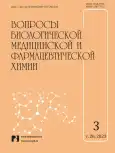The influence of endogenous polyphenols, photoperiod and mineral composition of the nutrient medium on the formation of callus tissue of relic gymnosperms Sequoia sempervirens (D.Don) Endl.
- 作者: Zaitseva S.M.1, Kalashnikova E.A.1, Kirakosyan R.N.2
-
隶属关系:
- Russian State Agrarian University – Moscow Agricultural Academy named after K.A. Timiryazeva
- Russian State Agrarian University - Moscow Agricultural Academy named after K.A. Timiryazeva
- 期: 卷 26, 编号 3 (2023)
- 页面: 46-57
- 栏目: Plant protection and biotechnology
- URL: https://journals.eco-vector.com/1560-9596/article/view/321416
- DOI: https://doi.org/10.29296/25877313-2023-03-06
- ID: 321416
如何引用文章
详细
Relrvance. Sequoia sempervirens (D.Don) Endl. are the tallest relict long–lived plants characterized by a limited range of growth. Valuable sequoia wood is able to accumulate unique secondary metabolites that do not have synthetic analogues. Sequoia plants grow in specialized microecological niches that limit their natural distribution area. It is known that biotic stress is one of the main environmental factors limiting the introduction of valuable plant species – possible sources of production of unique metabolites. Limiting environmental factors have a direct impact on the growth, development and productivity of secondary plant metabolism. Stress-resistant and highly productive plants can be created using cell biotechnology methods, in particular, in vitro cell selection, which is carried out on a callus culture. Therefore, at the first stage, it is necessary to develop in vitro technology for the rapid production of well-proliferating callus tissue.
Purpose of the study. To study the effect of the mineral composition of the nutrient medium, photoperiod and endogenous polyphenols on the formation of the callus tissue of sequoia (Sequoia sempervirens (D.Don) Endl.) in vitro.
Material and methods. The object of the study was Sequoia sempervirens (D.Don) Endl. plants. Callus tissue was obtained from segments of leaf blades and stem internodes, which were isolated from intact plants. Explants were cultured on MS and WPM nutrient medium containing BAP 2.5 mg/l and 2.5 mg/L 2,4-D. The localization of phenolic compounds was studied in the leaves, stems, apical buds of sequoia plants, as well as in callus tissue obtained on a nutrient medium with different mineral composition and under different lighting conditions. To do this, histochemical methods were used: for the sum of phenolic compounds, the material was stained with 0.08% Fast Blue reagent raster, a reaction with vanillin reagent in hydrochloric acid vapor was used to study the localization of flavans (catechins and proanthocyanidins).
Results. It was found that the applied lighting mode had a significant effect on the intensity of callus tissue formation, its consistency and color. A well-proliferating callus tissue of light yellow color was obtained on two types of nutrient media with no light source. At a 16–hour photoperiod, a dark brown callus tissue was formed, which died during cultivation. As a rule, callus tissue was formed in those places where the localization of phenolic compounds was insignificant. It was found that in the initiated callus cultures grown on the studied nutrient media with no illumination, the content of cells with phenolic compounds was less than that of callus obtained on the same nutrient media, but with the presence of illumination.
Conclusion. Sequoia plants have the ability to synthesize polyphenols, including the flavan series, which is preserved under in vitro conditions. The mineral composition of the studied nutrient media does not significantly affect the biosynthetic ability to form polyphenols in vitro cultures and their growth characteristics.
全文:
作者简介
S. Zaitseva
Russian State Agrarian University – Moscow Agricultural Academy named after K.A. Timiryazeva
编辑信件的主要联系方式.
Email: smzaytseva@yandex.ru
Ph.D. (Biol.), Associate Professor, Department of Biotechnology
俄罗斯联邦, MoscowE. Kalashnikova
Russian State Agrarian University – Moscow Agricultural Academy named after K.A. Timiryazeva
Email: kalash0407@mail.ru
Dr.Sc. (Biol.), Professor, Department of Biotechnology
俄罗斯联邦, MoscowR. Kirakosyan
Russian State Agrarian University - Moscow Agricultural Academy named after K.A. Timiryazeva
Email: mia41291@mail.ru
Ph.D. (Biol.), Associate Professor, Department of Biotechnology
俄罗斯联邦, Moscow参考
- Alekseeva G.M., Belodubrovskaja G.A., Blinova K.F., Goncharov M.Ju., Zhohova E.V. Farmakognozija. Lekarstvennoe syr'e rastitel'nogo i zhivotnogo proishozhdenija. Pod red. G.P. Jakovleva. Sankt-Peterburg. SpecLit. 2013.
- Nosov A.M. Reguljacija sinteza vtorichnyh soedinenij v kul'ture kletok rastenij. Biologija kul'tiviruemyh kletok i biotehnologija rastenij. Pod red. R.G. Butenko. M.: Nauka. 1991.
- Tjukavkina N.A. Bioflavonoidy. M.: Izdatel'skij dom «Russkij vrach». 2002. 56 s.
- Budanova E.V., Gorlenko K.L., Kiselev G.Ju. Vtorichnye metabolity rastenij: mehanizmy antibakterial'nogo dejstvija i perspektivy primenenija v farmakologii. Antibiotiki i himioterapija. 2019; 64: 5–6.
- Mamadalieva N.Z., Mamedov N.A. Taxus brevifolia a High-Value Medicinal Plant, as a Source of Taxol. Medicinal and Aromatic Plants of North America. Springer, Cham. 2020: 201–218.
- Zhang J., D'Rozariо A., Adams J.M. Sequoia maguanensis, a new Miocene relative of the coast redwood, Sequoia sempervirens, from China: Implications for paleogeography and paleoclimate. American Journal of Botany. 2015; 102(1). doi: 10.3732/ajb.1400347
- Laoué J., Fernandez C., Ormeño E. Plant Flavonoids in Mediterranean Species: A Focus on Flavonols as Protective Metabolites under Climate Stress. Plants. 2022; 11: 172.
- Zaprometov M.N. Fenol'nye soedinenija i ih rol' v zhizni rastenija. LVI Timirjazevskie chtenija. M.: Nauka. 1996. 45 s.
- Libby W.J. Cloning coast redwoods. California Agriculture. 1982; 36(8): 34–35.
- Soukupova J., Cvikrova M., Albrechtova J., Rock B.N., Eder J. Histochemical and Biochemical Approaches to the Study of Phenolic Compounds and Peroxidases in Needles of Norway Spruce (Picea abies). New Phytol. 2000; 146: 403414.
- Lakin G.F. Biometrija: ucheb. posobie dlja biol. spec. vuzov. M.: Vysshaja shkola. 1990. 352 s.
- Dubravina G.A., Zajceva S.M., Zagoskina N.V. Izmenenija v obrazovanii i lokalizacii fenol'nyh soedinenij pri dedifferenciacii tkanej tissa jagodnogo i tissa kanadskogo v uslovijah in vitro. Fiziologija rastenij. 2005; 52: 755–762.
- Kalashnikova, E.A., Zajceva S.M., Doan Thu Thui, Kirakosjan R.N. Vlijanie reguljatorov rosta na morfogeneticheskuju aktivnost' jeksplanotov Dioscorea nipponica Makino i obrazovanie polifenolov. Mezhdunarodnyj nauchno-issledovatel'skij zhurnal. 2020; 6–2(96): 6–11.
- Zagoskina N.V., Dubravina G.A., Aljavina A.K., Goncharuk E.A. Vlijanie ul'trofioletovoj (UF-B) radiacii na obrazovanie i lokalizaciju fenol'nyh soedinenij v kallusnyh kul'turah chajnogo rastenija. Fiziologija rastenij. 2003; 50(2): 302–308.
- Zametov M.N. Nikolaeva T.N. The ability of isolated chloroplasts from bean leaves to carry out biosynthesis of phenolic compounds. 2003; 50(5): 699–702.
补充文件















